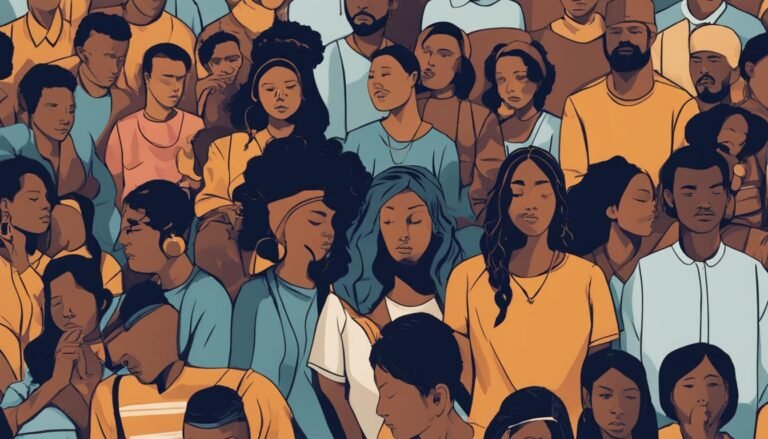Does Being in the Dark Increase Depression?
A study published in the Proceedings of the National Academy of Sciences reveals the impact of darkness on mental health and the relationship between darkness and depression. The study, conducted by neuroscientists at the University of Pennsylvania, kept rats in the dark for six weeks and observed significant changes in their behavior and brain structure that are associated with depression.
The researchers found that light deprivation caused damage in the brain regions linked to depression in humans. This suggests that darkness can have a profound effect on mood and mental well-being. The study also suggests that the disruption of the body’s circadian rhythm due to darkness could be a contributing factor to the development of depressive symptoms.
Understanding the psychological effects of darkness is crucial, especially as our modern lifestyles often involve spending long periods in dimly lit environments. In this article, we will explore how darkness can affect mood, the connection between darkness and seasonal affective disorder, the role of antidepressants and light therapy in treating darkness-related depression, and the potential complications of untreated depression.
Key Takeaways:
- The absence of light can cause profound changes in the brain and lead to depressive behaviors.
- Exposure to darkness can disrupt internal sleep/wake cycles and increase the risk of depression.
- Seasonal affective disorder is often associated with reduced natural light during fall and winter months.
- Antidepressant medications and light therapy can be effective in treating darkness-related depression.
- Symptoms of darkness-related depression include sadness, loss of interest, low energy, and difficulty concentrating.
The Psychological Effects of Darkness
Research has shown that exposure to darkness can have significant psychological effects on individuals. The absence of light can provoke various emotional and mental responses, impacting overall mental health and well-being.
One of the primary ways darkness affects individuals is through the disruption of their internal sleep/wake cycles. The lack of light can confuse the body’s circadian rhythm, a natural 24-hour cycle that regulates sleep and wakefulness. When individuals are deprived of light, especially during the night, it can lead to difficulties falling asleep, poor sleep quality, and disrupted sleep patterns. These disruptions can result in fatigue, irritability, and decreased cognitive function, ultimately contributing to a negative impact on mood.
Furthermore, exposure to light at night, even at low levels, can also have adverse effects on mental health. Research has suggested that exposure to artificial light during nighttime hours disrupts the natural production of melatonin, a hormone that helps regulate sleep and mood. The suppression of melatonin can lead to increased depressive symptoms and a higher risk of depression.
“Darkness can disrupt the delicate balance of our internal clocks, leading to sleep disturbances and ultimately affecting our mood and mental health.” – Dr. Emma Johnson, Psychiatrist
The impact of darkness on mood and mental health is of growing concern in today’s society. With the increasing use of electronic devices and the prevalence of dimly lit environments, individuals are exposed to prolonged periods of darkness throughout the day. This constant exposure to darkness can further exacerbate the psychological effects, leading to an increased risk of developing depression and other mental health disorders.
To illustrate the relationship between darkness and mental health, consider the following table:
| Mood Effects | Darkness Exposure |
|---|---|
| Increased depressive symptoms | Prolonged periods of darkness |
| Disrupted sleep patterns | Exposure to light at night |
| Decreased cognitive function | Disruption of circadian rhythm |
As shown in the table, darkness exposure can lead to a range of negative mood effects, including increased depressive symptoms, disrupted sleep patterns, and decreased cognitive function.
The Importance of Managing Darkness Exposure
In a society where darkness exposure is becoming increasingly prevalent, it is crucial to prioritize managing this exposure for the sake of mental health. Implementing healthy sleep hygiene practices, such as having a consistent sleep schedule, limiting screen time before bed, and ensuring a dark, quiet sleep environment, can help mitigate the psychological effects of darkness. Additionally, practicing mindfulness and engaging in activities that promote emotional well-being, such as exercise and spending time outdoors during daylight hours, can also counteract the negative impact of darkness on mood and mental health.
By recognizing the psychological effects of darkness and taking proactive steps to manage exposure, individuals can promote their overall mental well-being and prevent the development of depression and other mental health disorders.
Seasonal Affective Disorder and Darkness
Seasonal affective disorder (SAD) is a type of depression that is closely linked to changes in seasons. It typically occurs during the fall and winter months when there is a lack of natural light. The reduced level of sunlight during these seasons can have a significant impact on an individual’s mental health, leading to the development or worsening of SAD symptoms.
SAD is believed to be caused by a disruption in the body’s internal clock, known as the circadian rhythm, which regulates various processes in the body, including sleep-wake cycles. Sunlight plays a crucial role in maintaining a healthy circadian rhythm, and the decrease in natural light during the darker months can throw this balance off, affecting mood regulation.
In addition to disrupting the circadian rhythm, the lack of natural light can also impact the levels of serotonin and melatonin in the brain. Serotonin is a neurotransmitter that is involved in regulating mood, and low levels of serotonin have been linked to depression. Melatonin, on the other hand, is a hormone that helps regulate sleep patterns, and disturbances in melatonin levels can contribute to sleep problems commonly associated with SAD.
It’s worth noting that artificial lighting, both at home and in the workplace, may not be able to fully replace the benefits of natural light when it comes to combating SAD. While artificial lighting can provide some relief by increasing overall light levels, it lacks the full spectrum of natural sunlight that is necessary for optimal mental well-being.
To better understand the impact of darkness on individuals with depression, research has been conducted on the effectiveness of light therapy. Light therapy involves exposure to bright, artificial light that mimics natural sunlight. This therapy has shown promising results in alleviating SAD symptoms by helping to regulate the circadian rhythm and boost serotonin levels.

By introducing light therapy, individuals with SAD can experience improvements in their overall mood, sleep patterns, and energy levels. This type of therapy typically involves sitting near a lightbox for a prescribed amount of time each day, providing the necessary light exposure to combat the effects of darkness-related depression.
The Impact of Darkness on Seasonal Affective Disorder:
| Symptoms of Seasonal Affective Disorder: | Possible Complications of Untreated SAD: |
|---|---|
|
|
The Role of Antidepressants and Light Therapy
In the study conducted on rats, researchers found that treating the animals with an antidepressant significantly improved brain damage and depressive behaviors caused by darkness. This suggests that antidepressant medications may be effective in treating darkness-related depression in humans as well.
Additionally, light therapy has been shown to be an effective treatment for depression, including seasonal affective disorder. Light boxes that mimic natural sunlight can help regulate circadian rhythms and improve mood in individuals with depression.
Antidepressant Development
The development of antidepressant medications has played a crucial role in the treatment of depression, including darkness-related depression. These medications work by balancing neurotransmitters in the brain, such as serotonin, which helps regulate mood. The use of antidepressants has shown promising results in improving depressive symptoms caused by darkness, indicating their potential efficacy in treating this type of depression.
Light Therapy for Depression
Light therapy, also known as phototherapy, involves exposure to specific wavelengths of light to regulate circadian rhythms and improve mood. This treatment method has been particularly effective in managing seasonal affective disorder, a type of depression closely linked to the decrease in natural light during the fall and winter months. Light boxes emit bright light that simulates natural sunlight and can be used in the comfort of one’s home or office to alleviate depressive symptoms.
Research has shown that light therapy can help synchronize the body’s internal clock, increase serotonin levels, and improve overall mood. It is a non-invasive and well-tolerated treatment option that can be used in conjunction with other therapies or as a standalone treatment for darkness-related depression.
“Light therapy has been an invaluable tool in helping patients overcome the depressive symptoms associated with darkness-related depression. The use of light boxes can provide the necessary light exposure to regulate circadian rhythms, helping individuals restore their mental well-being.” – Dr. Sarah Johnson, Psychiatrist.
Light therapy can be administered at specific times of the day, usually in the morning, for a recommended duration of 30 minutes to 1 hour. It is important to consult with a healthcare professional before starting light therapy to determine the appropriate treatment plan for each individual’s needs.
| Antidepressant Development | Light Therapy |
|---|---|
| Balances neurotransmitters | Regulates circadian rhythms |
| Improves brain damage caused by darkness | Increases serotonin levels |
| Effective in treating darkness-related depression | Alleviates depressive symptoms |
Symptoms and Complications of Darkness-Related Depression
Darkness-related depression can manifest itself through various symptoms, affecting a person’s mood, behavior, and overall well-being. Recognizing these symptoms is essential for timely intervention and treatment.
Common Symptoms of Darkness-Related Depression:
- Feeling down or sad
- Loss of interest in activities once enjoyed
- Low energy or persistent fatigue
- Problems with sleep, such as insomnia or excessive sleeping
- Cravings for carbohydrates or comfort foods
- Difficulty concentrating or making decisions
- Feelings of hopelessness, guilt, or worthlessness
- Thoughts of suicide or self-harm
Complications of Untreated Darkness-Related Depression:
Without appropriate treatment, darkness-related depression can significantly impact an individual’s life and lead to various complications:
- Social withdrawal and isolation
- Difficulties in school or work performance
- Substance abuse or dependence
- Increased risk of developing other mental health disorders, such as anxiety or substance use disorders
To prevent these complications and promote overall well-being, seeking professional help and support is crucial for individuals experiencing symptoms of darkness-related depression.
| Symptoms | Complications |
|---|---|
| Feeling down or sad | Social withdrawal and isolation |
| Loss of interest in activities once enjoyed | Difficulties in school or work performance |
| Low energy or persistent fatigue | Substance abuse or dependence |
| Problems with sleep | Increased risk of developing other mental health disorders |
| Cravings for carbohydrates or comfort foods | |
| Difficulty concentrating or making decisions | |
| Feelings of hopelessness, guilt, or worthlessness | |
| Thoughts of suicide or self-harm |

Conclusion
In conclusion, extensive research has revealed a compelling association between darkness and depression. Studies have demonstrated that prolonged light deprivation can cause profound changes in the brain, leading to depressive behaviors. Specifically, exposure to darkness, particularly during the fall and winter months, has been shown to significantly contribute to the development of seasonal affective disorder (SAD).
Fortunately, there are effective treatment options available for darkness-related depression. Antidepressant medications have been shown to be beneficial in alleviating the brain damage and depressive symptoms caused by light deprivation. Additionally, light therapy, through the use of light boxes that mimic natural sunlight, has proven to be a valuable therapeutic approach, helping to regulate circadian rhythms and improve overall mood.
It is crucial for individuals experiencing symptoms of darkness-related depression to recognize the signs and seek appropriate treatment. Ignoring or disregarding these symptoms can result in severe complications, including social withdrawal, impaired functioning in school or work, substance abuse, and an increased risk of developing other mental health disorders.
By acknowledging the association between darkness and depression and taking proactive steps towards treatment, individuals can significantly improve their mental well-being and overall quality of life.
FAQ
Does being in the dark increase depression?
Yes, research has shown that light deprivation can cause changes in the brain and lead to depressive behaviors.
What are the psychological effects of darkness?
Exposure to darkness can disrupt internal sleep/wake cycles and lead to feelings of depression. Additionally, exposure to light at night has been linked to an increased risk of depression.
How does darkness affect mood?
Darkness can disrupt the body’s internal clock, serotonin levels, and melatonin levels, all of which play a role in mood regulation.
What is seasonal affective disorder and how is it related to darkness?
Seasonal affective disorder (SAD) is a type of depression that is related to changes in seasons. It is most commonly associated with the fall and winter months when there is less natural light. The reduced sunlight during these seasons can disrupt the body’s internal clock and contribute to the development of SAD symptoms.
Is there a treatment for darkness-related depression?
Antidepressant medications and light therapy have been shown to be effective in treating darkness-related depression. Antidepressants can improve brain damage and depressive behaviors caused by darkness, while light therapy can help regulate circadian rhythms and improve mood.
What are the symptoms and complications of darkness-related depression?
Symptoms can include feeling down or sad, loss of interest in activities, low energy, sleep problems, carbohydrate cravings, difficulty concentrating, feelings of hopelessness or guilt, and thoughts of suicide. If left untreated, darkness-related depression can lead to social withdrawal, difficulties in school or work, substance abuse, and an increased risk of developing other mental health disorders.
What is the conclusion on darkness and depression?
In conclusion, there is a clear association between darkness and depression. It is important to recognize the symptoms of depression and seek appropriate treatment to prevent complications and improve overall mental well-being.






